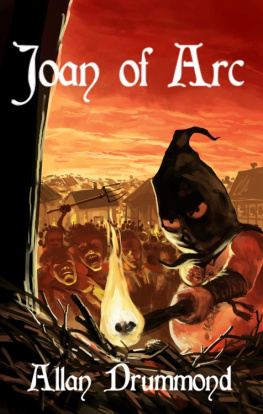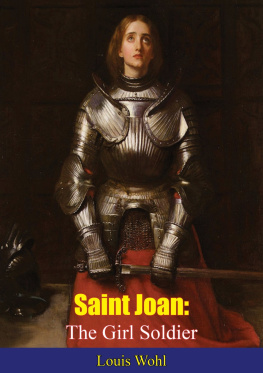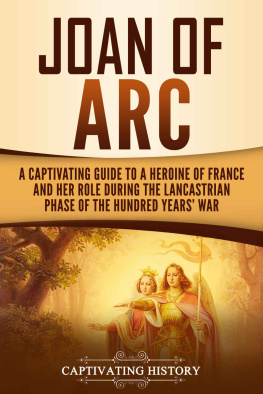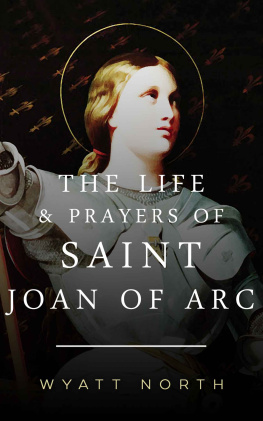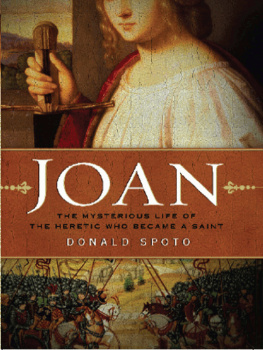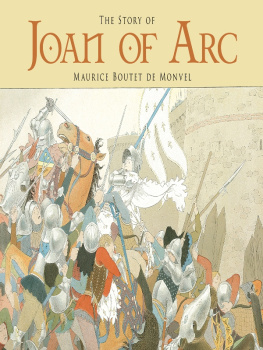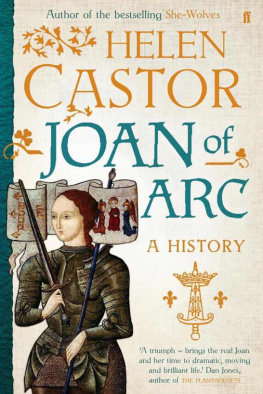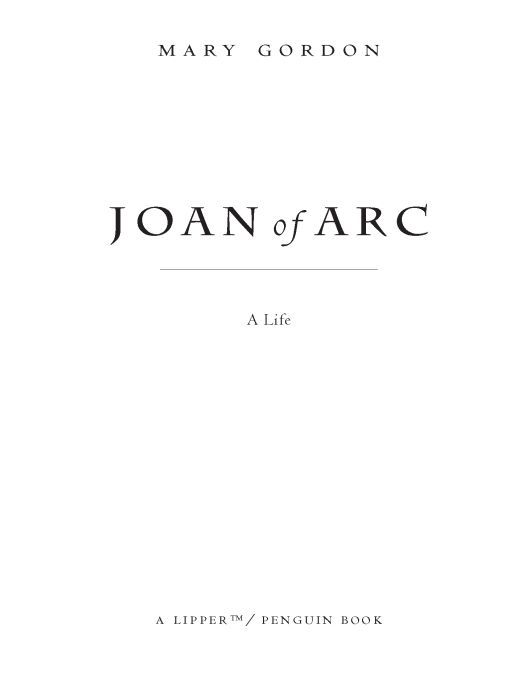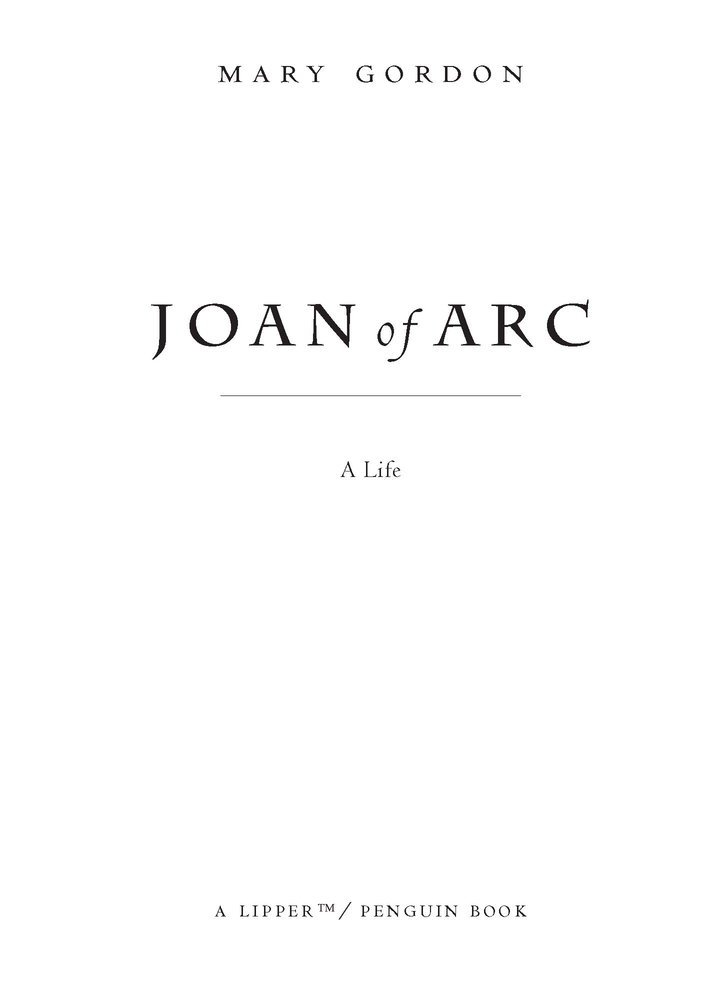Table of Contents
Praise for Joan of Arc
Gordon writes not as a professional biographer, or as a historian, but as a master of the story form, as a careful reader, as a woman attuned to power and longing and as a believer for whom God is a mystery but not a stranger. Gordon is perfectly matched with Joan of Arc, and the book she has written is both a compelling life story and a shrewd analysis of the mythical uses to which it has been put. The New York Times Book Review
Agree or disagree with Gordons numerous insights and interpretations, she gives us Joan as she was, letting us fully appreciate why the Maid will grip our attention for all time. Forbes
Gordons biographical meditation is a readable and substantive introduction to the life and meaning of this medieval heroine.
Christian Century
A bold biographical meditation that persuades the skeptic to meditate on the inexplicable something Joan made happen, and keeps on happening, to this day. Kirkus Reviews
"Gordon avoids the dramatic and approaches her brassy, devout and defiant subject with a thoughtful air. Joan of Arc is an engaging meditation on one of the Wests most memorable figures.
Star-Telegram (Fort Worth)
A large part of the enjoyment here is the highly personal intelligence of Gordons prose style, laying out the facts of Joans career and her martyrdom, and considering their ramifications.
Seattle Post-Intelligencer
ABOUT THE AUTHOR
Mary Gordon, McIntosh Professor of English at Barnard College, is the bestselling author of six novels, three collections of short stories, and two memoirs. She lives in New York City.
TO ANTOINETTE OCEALLAIGH
who also grew up
thinking of Joan
Acknowledgments
THERE ARE over twenty thousand books about Joan of Arc in the Bibliotheque Nationale in Paris. This figure suggests the impossibility of reading even a substantial portion of what has been written about her. I am particularly indebted, therefore, to two excellent studies on Joan, Edward Lucie-Smiths and Marina Warners, both entitled Joan of Arc.
Posterity has been fortunate that the records of Joans trial have been preserved. The translation of the trial record I used is by W. S. Scott. The text was taken from an original known as the Orlans Manuscript.
I am greatly indebted to the generosity of two of my colleagues at Barnard College: Joel Kaye of the Department of History and Christopher Baswell of the Department of English. I also wish to thank Joanne MacNamara, Professor Emerita of History at Hunter College.
For his heroic patience and help, my thanks go to my husband, Arthur Cash, frustrated military historian and footnote fetishist extraordinaire, whose distinction as a biographer humbles me as a would-be colleague, but fills me with pride as an actual wife.
Chronological Table
1337 The Hundred Years War begins
1412Jan. 6 probably Birth of Joan of Arc
1420 The Treaty of Troyes
1424Midsummer probably Joan first hears the voices
1428July Flight to Neufchtel
1429Jan.-Feb. Visit to Vaucouleurs
Feb. 23 Joan leaves Vaucouleurs for Chinon
March 6 Arrival at Chinon
March 9 (approx.) Received by the dauphin
March -April At Chinon, Poitiers, Tours, and Blois
April 28 Arrival before Orlans
April 29 Enters Orlans
April 29-May 10 At Orlans
May 7 Journe des Tourelles
May 8 The siege raised
May 10 Departure from Orlans
June 11-12 Capture of Jargeau
June 15 At Meung-sur-Loire
June 16-17 Capture of Beauregency
June 18 Battle of Patay
July 17 Charles VII crowned
July 21 Charles VII and Joan leave Rheims
1429Aug. 12 At Lagby-le-Sec
Aug. 18-23 At Compigne
Aug. 26-Sept. 8 At St.-Denis and La Chapelle
Sept. 8 Attack on Paris (Joan wounded)
Sept. 9 La Chapelle and St.-Denis
Sept. 10 and 13 At St.-Denis
Sept. 13 Departure from St.-Denis for the Loire
Nov. 24 Attack on La Charit
1430April Battle of Lagny
May 23 Compigne and assault on Margny; Joan taken prisoner
? May, June, July At Beaulieu, a prisoner
Dec. 25-May 30 Prisoner in a tower of castle of Phillipe Auguste, Rouen
1431Jan. 3 Delivered to the Inquisition and the Church by the English
Jan. 9 Trial begins
May 24 The recantation
May 30 Burned at the stake
1450 Examination of witnesses for the rehabilitation begins, under the direction of Guillaume Bouill
1452 Resumes under Cardinal dEstouteville, bishop of Digne, and Jean Brehal, inquisitor of France
1455-1456 Continued by order of Pope Calixtus III
1456July The sentence revoked by Pope Calixtus III
Introduction
She is one of the few figures in history who cannot be anything but protagonists, who are never subordinate, always an end and never a means.
JOHAN HUIZINGA
Charisma... bursts the bonds of rules and tradition and overturns all ideas of the sacred. It enforces a subjection to something which has never before existed.
MAX WEBER
Youth forgets itself in its own ardor.... When youth has once grasped where beauty dwells, its self-surrender is absolute.
ALFRED NORTH WHITEHEAD
MARCH 14, 1999. The city of Rouen, the province of Normandy, the country of France, the continent of Europe. It is 5 P.M. on an unseasonably warm spring day. People have flung their jackets over their shoulders. They are sitting outside in cafs, reckless from the sunlight, which seems miraculous, unearned, suggestive of improvidence. We are in the marketplace, the place where Joan of Arc was burned at the stake. An attempt has been made to make this a viable city center; there is an open space for a market and, next to it, a cathedral. It is one of those good ideas that didnt work; it might have worked had there been a genius to design it, but it was not designed by a genius. The church is in the shape of an overturned boat, and the motif is meant to be nautical: Rouen is a seafaring city. But the idea fails; it provides us only with the always dispiriting spectacle of overstrained originality. The church has the sad, earnest quality of mediocre modern architecture, and we are left with a sense of betrayal, because we think that plain materials and an abundance of light ought to equal beauty, and when they dont, not only art, but nature as well, has let us down.
It is a Sunday, late afternoon. A ruddy light hangs low over the pavement. In the way of failed modern spaces, this one has become a haven for the underemployed, unprosperous young. Boys with greasy hair and tattoos throw their cigarette butts onto the ground. Two other, younger boys are throwing a soccer ball, with a disturbing violence, against the wall of the marketplace. They throw it against the words Andr Malraux wrote in 1964 when he dedicated this complex:


